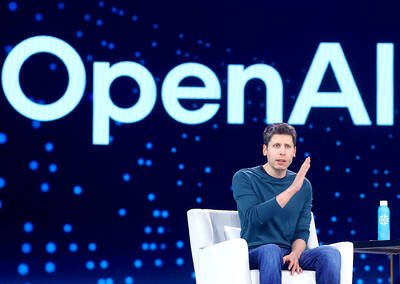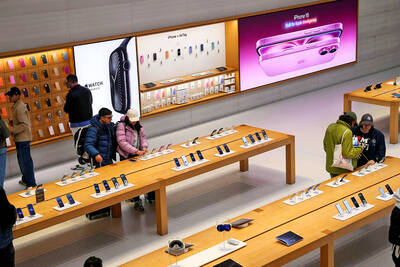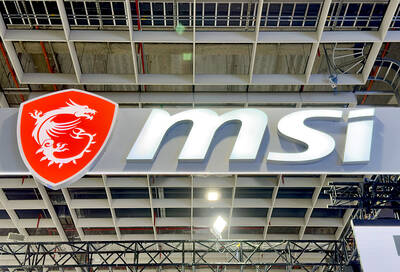Apple Inc’s new iPhone goes on sale today with a bigger screen and 4G wireless technology, as the company seeks to safeguard its edge over rivals like Samsung Electronics Co and Google Inc.
The iPhone 5 fulfilled many of the expectations laid out by gadget geeks and technology analysts ahead of its Wednesday unveiling, but offered few surprises to give Apple shares — already near record highs — another major kick.
“There is not a wow factor because everything you saw today is evolutionary. I do think they did enough to satisfy,” said Michael Yoshikami, chief executive of wealth management company Destination Wealth Management.
Apple shares ended the day up 1.4 percent at US$669.79.
The latest iPhone comes as Apple faces competition beyond current key competitors Samsung and Google. Late entrant Microsoft Corp is now trying to push its Windows Phone 8 operating system as an alternative to Apple and Android, the most-used smartphone operating system in the world.
SALES FORECASTS
Analysts have forecast sales of 10 million to 12 million of the new iPhones in this month alone.
Apple chief executive Tim Cook opened the event in San Francisco’s Yerba Buena Center, but it was marketing chief Phil Schiller who introduced the iPhone 5 and took the audience through the new phone’s features.
The iPhone 5 sports a 4-inch “retina” display, can surf a high-speed 4G long-term evolution (LTE) wireless network and is 20 percent lighter than the previous iPhone 4S.
It ships starting Friday next week in the US, Australia, Canada, France, Germany, Hong Kong, Japan, Singapore and Britain. It will hit 100 countries by the end of the year in the fastest international rollout for an iPhone so far.
The stakes are high with the iPhone, Apple’s marque product, accounting for nearly half its revenue. The California company has sold more than 243 million iPhones since 2007, when the device ushered in the current applications ecosystem model.
However, Samsung now leads the smartphone market with a 32.6 percent share, followed by Apple with 17 percent, according to market research firm International Data Corp. Both saw shipments rise compared with a year ago, with Samsung riding its flagship Galaxy S III phone.
Available for pre-order today starting from US$199 with a data plan, the iPhone 5 comes with Apple’s newest “A6” processor, which executives said runs twice as fast as the previous generation. It will pack three microphones — enhancing built-in voice assistant Siri — and an 8 megapixel camera that can take panoramic views.
It will hitch a ride on the three largest US carriers: Verizon Wireless, AT&T Inc and Sprint.
One popular enhancement was improved battery endurance — the iPhone 5 can support eight hours of 4G Web browsing, the company said.
While Apple played catch-up on many of the new phone’s features — Samsung and Google’s Motorola already have larger and 4G-ready phones — analysts say the device’s attraction is the way its software and hardware work in tandem.
‘THE EXPERIENCE’
“Where they are pushing the envelope, and where they remain the one to beat, is on the experience those features bring to the consumer,” Gartner Research analyst Carolina Milanesi said. “While other vendors continue to focus just on the hardware — delivering the speeds and feeds and bigger batteries — Apple focuses on pulling the operating system, the hardware and what you can consume on the hardware.”
For the iPhone 5, Apple has done away with the connectors used on previous devices and replaced them with a smaller and more efficient “Lightning” connector. It is also shipping new “EarPods” audiophones, designed after digitally scanning hundreds of ears.
Beyond hardware, Apple telegraphed many of the software changes to expect in iPhone 5 when it debuted iOS 6, its latest mobile operating system, in June.
Upgrades to the software include voice navigation for driving, a feature already available on many Android smartphones, as well as “Passbook” for storing electronic boarding passes, sports tickets and gift cards.
Siri has been improved. In an onstage demonstration, Siri was able to answer questions about the result of a recent pro football game and recite a list of movies playing around town, along with ratings.
Earlier, Cook told the audience that its apps store now has more than 700,000 on tap — the industry’s largest library.

Meta Platforms Inc offered US$100 million bonuses to OpenAI employees in an unsuccessful bid to poach the ChatGPT maker’s talent and strengthen its own generative artificial intelligence (AI) teams, OpenAI CEO Sam Altman has said. Facebook’s parent company — a competitor of OpenAI — also offered “giant” annual salaries exceeding US$100 million to OpenAI staffers, Altman said in an interview on the Uncapped with Jack Altman podcast released on Tuesday. “It is crazy,” Sam Altman told his brother Jack in the interview. “I’m really happy that at least so far none of our best people have decided to take them

BYPASSING CHINA TARIFFS: In the first five months of this year, Foxconn sent US$4.4bn of iPhones to the US from India, compared with US$3.7bn in the whole of last year Nearly all the iPhones exported by Foxconn Technology Group (富士康科技集團) from India went to the US between March and last month, customs data showed, far above last year’s average of 50 percent and a clear sign of Apple Inc’s efforts to bypass high US tariffs imposed on China. The numbers, being reported by Reuters for the first time, show that Apple has realigned its India exports to almost exclusively serve the US market, when previously the devices were more widely distributed to nations including the Netherlands and the Czech Republic. During March to last month, Foxconn, known as Hon Hai Precision Industry

PLANS: MSI is also planning to upgrade its service center in the Netherlands Micro-Star International Co (MSI, 微星) yesterday said it plans to set up a server assembly line at its Poland service center this year at the earliest. The computer and peripherals manufacturer expects that the new server assembly line would shorten transportation times in shipments to European countries, a company spokesperson told the Taipei Times by telephone. MSI manufactures motherboards, graphics cards, notebook computers, servers, optical storage devices and communication devices. The company operates plants in Taiwan and China, and runs a global network of service centers. The company is also considering upgrading its service center in the Netherlands into a

Taiwan’s property market is entering a freeze, with mortgage activity across the nation’s six largest cities plummeting in the first quarter, H&B Realty Co (住商不動產) said yesterday, citing mounting pressure on housing demand amid tighter lending rules and regulatory curbs. Mortgage applications in Taipei, New Taipei City, Taoyuan, Taichung, Tainan and Kaohsiung totaled 28,078 from January to March, a sharp 36.3 percent decline from 44,082 in the same period last year, the nation’s largest real-estate brokerage by franchise said, citing data from the Joint Credit Information Center (JCIC, 聯徵中心). “The simultaneous decline across all six cities reflects just how drastically the market